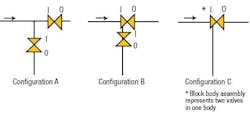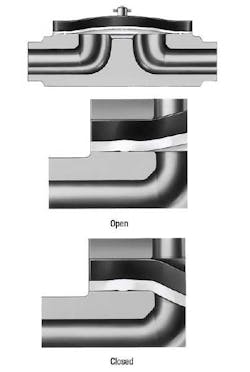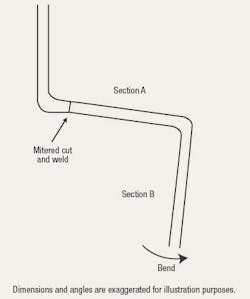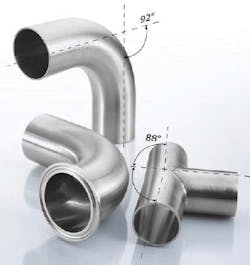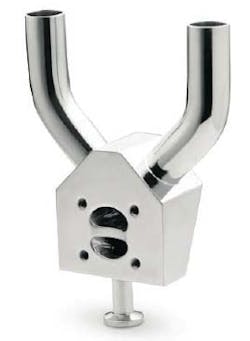Cleanliness and drainability are among the most critical issues that manufacturers of products such as biopharmaceuticals and active pharmaceutical ingredients (APIs) must confront with their process lines. Producers face the prospect of losing millions of dollars each year because of improperly sloped process lines and entrapment in valves and fittings.
Some products suit continuous processes. Typically, however, manufacturers must run multiple batches and must clean between them using steam in place (SIP), clean in place (CIP) with a chemical agent, or both techniques. When a valve is shut off in a properly constructed system, the entire system downstream should completely drain, minimizing residual puddles, reservoirs or entrapment along process lines or in or around valves or fittings.
Variables that will impact a system’s drainability and cleanability include:
- system slope;
- deadlegs;
- interior surface finish of tubing;
- valve and fitting selection and design; and
- fitting-to-valve ratio.
Owners and contractors alike can take steps in the design and construction phase to enhance the drainability and cleanability of a system. However, the onus rests on the owner to make these top-line requirements.
System slope, deadlegs and interior surface finish
Some specific guidelines concerning system slope and drainability are given in ASME-BPE section SD 3.12. Although the ASME-BPE standard doesn’t designate a specific slope, most companies abide by the commonly accepted guideline of a minimum ⅛ or ¼ inch per foot. Or for every foot of tubing, the line should drop a minimum of ⅛ in. to ¼ in.
Deadlegs are sections of tubing, typically tees leading to valves or valve assemblies, characterized by a discontinuity of flow. During cleaning, chemicals or steam may not reach these locations, or fluid can be held up there and not fully drain, leading to contamination. Minimizing deadlegs when designing a system is vital. Deadlegs can be managed in three ways (Figure 1), listed below from least to most desirable:
Figure 1. Three options are available, with configuration C, depicting a block body assembly, the best.
In Configuration A, a tee fitting with three welds creates a horizontal line to a valve. The deadleg is the area between the tee fitting and the valve. This arrangement creates the longest deadleg of the three options because the valve’s proximity to the intersection is limited by the tee stub. When selecting this configuration, a designer’s best approach is to choose tees whose stubs are shortest in length and widest in diameter, which will facilitate access when cleaning and minimize the area for fluid hold-up.
Configuration B uses a valve instead of a tee fitting. The tee is created by boring a hole into the side or bottom of the valve. A vertical line is welded into the valve to create the tee formation. The distance to the valve on the vertical line (the dead leg) is now shorter than in Configuration A because the welded tee fitting is not part of the flow path.
Configuration C eliminates the deadleg altogether through the use of a custom valve assembly. In these assemblies, two valves actuate from the same block, one controlling vertical flow and the other horizontal flow. Block body assemblies can be produced more cost efficiently by some companies than manufacturing two valves separately.
The interior surface finish of tubing affects both drainability and cleanability. A smooth finish, with no porosity or pitting, means better performance in both areas. Cleanability can be enhanced further by electropolishing, which adds a chemically inert layer that inhibits corrosion. The finish can be checked with special tools and by visual examination.
Valve and fitting selection and design
Carefully consider valve selection. For instance, in critical shut-off applications, the most common options are weir-style and radial diaphragm valves. The weir-style valve offers a proven track record of solid performance in validated systems. Yet its sealing design can leave some opportunity for entrapment or contamination. The diaphragm is designed to seal on a sealing bead outside the weir area. However, in the open position, the diaphragm lifts up and flexes, exposing the valve body along the perimeter of the bowl (Figure 2).
Figure 2. Fluids may become trapped between the diaphragm and the valve when the diaphragm closes.
As the valve closes, the diaphragm closes back toward the body of the valve, trapping small quantities of fluid.
Newer radial diaphragm valve designs avoid such problems because the diaphragm seals along the edge of the valve’s bowl. At no time does the diaphragm lift beyond the edge of the bowl. As a result, entrapment doesn’t occur. Further, bowl shape, inlets and outlets are configured to ensure that the flow path is cleanly swept and optimized for full drainability. Not surprisingly, such valves are seeing increasing usage.
In choosing between weir-style and radial diaphragm valves, assess the sensitivity of the application to drainability, entrapment, potential contamination and system flow requirements. For example, the equivalent size weir-style valve would provide a higher flow rate and be the appropriate choice for applications requiring a higher flow, while radial diaphragm valves are well suited for applications where cleanliness or high-cycling is critical.
Fittings are another important factor in drainability. With standard 90° fittings, ASME-BPE permits a typical variability of ± 1.3°. Some contractors actually presort standard 90° fittings into those in the acute direction and those in the obtuse direction for use in different slope applications. This process is time-consuming and inexact.
Usually, standard 90° fittings require some additional angling to obtain the desired slope. There are two common methods to achieve this:
Using a facing tool, a mitered cut is made near the end of the 90° elbow. Then, a straight piece of tubing is butt-welded to the mitered cut, creating a slope. Some bending may be required to adjust the slope.
The second method requires only bare hands. A straight piece of tubing is butt-welded or otherwise attached to the fitting. Then, the installer grips the straight piece of tubing and forces it to the desired slope or position. In Figure 3, section A is mitered and section B is bent into place.
Figure 3. Fittings angled at 88º and 92º ensure proper drainability.
Both of these manual methods aren’t particularly accurate and, in fact, are banned at some plants. Moreover, they may compromise the integrity of the internal surface finish and so foster contamination. Also, tubing can spring back from its forced position with a change in temperature or when uncoupled for maintenance, upsetting the intended angle and resulting in reassembly challenges.
In contrast, special angled fittings can ensure proper drainability. Relatively new to the marketplace and available as elbows or tees (Figure 4), they come with bends of 88° or 92 °, with a tight tolerance of ± 0.5°.
Figure 4. Two techniques commonly are used to provide a slope in a dogleg.
These angles correspond to the requirements for a minimum slope of ⅛ in. to ¼ in. per ft. Such fittings come faced for butt welding, with welded flanges for clamp-end fittings, or with threads for threaded fittings.
The common four-bolt ANSI flange is unsanitary and therefore inappropriate for biopharmaceutical and other sanitary systems. The conventional ISO-2852-type tri-clamp fitting can be employed but poses issues of drainability and flow obstruction. As the clamp tightens, the gasket will extrude into the interior flow path. With thermal cycling, the bore intrusion may increase. Computational fluid dynamics (CFD) shows that such intrusion causes turbulence in the flow path and potential hold-up when the system is drained (Figure 5).
Figure 5. CFD shows how an ISO-2852 tri-clamp fitting can suffer from gasket extrusion into the flow path.
Fittings of an alternative design, such as the TS series, preclude gasket extrusion into the flow path by preventing over-tightening and providing an alternative space into which the gasket may extrude (during pull-up and clamping) or expand (during thermal cycling).
Fitting-to-valve ratio
Although there’s no generally accepted ratio of fittings to valves, use the dictum “less is more” as your guide. Minimizing the number of fittings and valve bodies will improve overall system efficiency, cost and performance. Quality valves are available with multiple combinations of inlets and outlets; so one multi-valve may do the job that used to require two or more individual valves. Such designs not only reduce the number of valve bodies but also the number of fittings because at least two fittings (or welds) are necessary for each valve. Smart valve choices result in fewer valves, a higher fitting-to-valve ratio and, likely, a reduction in overall system size and deadlegs.
One of the more critical valve applications occurs at point-of-use outlets. Traditionally, the point-of-use valve appears as a zero static tee. While the vertical stem of the tee may drain well, the horizontal sections may not. In some cases, 90° elbows may be added to — or replace — each side of the horizontal tee sections, creating an elbow header. A better option is the “Viking” design, which avoids any horizontal section in the tee formation and has 45° bends before entering the valve (Figure 6).
Figure 6. This alternative to a point-of-use valve with a static tee assures full drainability.
The distance between the two vertical drops coincides with ASME-BPE recommended dimensions for “U” drops. Weir-style or radial diaphragm valves may be employed in Viking formations.
Other considerations
Many subtleties come into play when designing systems. The following are the most important:
- Properly sized tubing is paramount. The correct inside diameter of the tubing relates to the volume of the system and the pressure of the cleaner to be used. The cleaner on hand must provide sufficient force to clean out the tubing.
- Steam is an effective cleaning method — but systems must be designed to tolerate it. Some elastomers (in gaskets and valve diaphragms) and cast-body products (in pumps, for instance) are not optimal for steam. In selecting gaskets and diaphragms, educate yourself on the many grades of elastomers. Always specify steam grades. Black residue in a system is a sign that a low-grade elastomer has eroded during steam cleaning. The steel in pumps, valves and the like must be forged, wrought, or machined. It’s difficult to control the metallurgy in casting; the process can give off ferrite ions that cause rust in the system when they come into contact with steam. PTFE can be used in SIP systems.
- Welds must be high quality. Serious problems can occur when welding two pieces of stainless steel with dissimilar metallurgy. For example, the weld pool can become asymmetric, favoring the low sulfur side, and the root of the weld may shift away from the joint. This effect can be minimized by matching sulfur contents within ± 0.010%; greater differences require adjustments to weld set-up to achieve full penetration to the root of the joint.
- The system must be properly supported. The weight of the tubing can cause sagging, as can technicians using the tubing as a step or handrail. To eliminate sagging, which can compromise the integrity of the system, a sloped system requires support in the form of specially made sloped tubing hangers.
Drain the system not your wallet
You must make careful, informed decisions about fluid system components to avoid significant financial losses or validation failures because of contamination or poor drainability. Pay attention to valves, fittings and system slope and consider hardware designed to ensure cleanliness and drainability.
Michael Bridge is a market manager for Swagelok Biopharm Services Company, Amherst, N.Y. E-mail him at [email protected].

